IN THIS ISSUE
- Record eagle nest results
- Georgia's wildest architects
- Winter hummers in summer
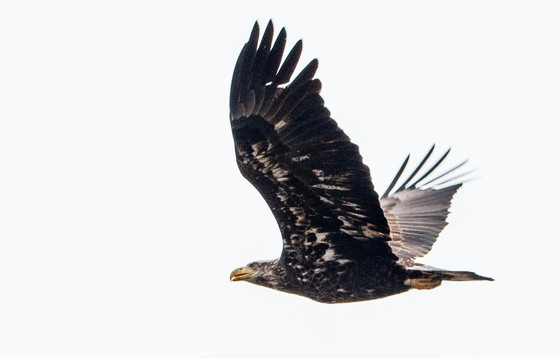 Juvenile bald eagle (Sherry Rosen/GNPA)
They’ve done it again. Georgia’s first statewide survey of bald eagle nests in five years revealed the national bird nesting here in record numbers.
Survey flights this winter and spring counted 229 nest territories. That tops the previous best of 218 set in 2017. (Except for COVID-related changes last year, DNR changed its surveys after 2017 to check most regions once every other year.)
Bald eagle nests this year fledged 227 young, or almost 1.6 each, according to Dr. Bob Sargent, who leads the annual monitoring. But while most nests had one to two eaglets, an ambitious couple near Columbus raised three eaglets to flight.
As DNR has noted (“Bald eagles and bird flu,” April), all nest news for the iconic raptors hasn’t been upbeat. The viral disease called highly pathogenic avian influenza cut nest success rates on the coast by about 30 percent. Fewer than half of those nests fledged young.
But Sargent, a program manager with DNR’s Wildlife Conservation Section, said the big picture is encouraging.
“It’s important to remember that the bald eagle population has exhibited a remarkable rebound in the last 50 years. And although the coastal nests took a hit from the virus, the more than 150 nests elsewhere in the state experienced normal productivity.”
WHAT YOU CAN DO
Want to help conserve bald eagles and other rare animals and plants in Georgia for future generations?
-
Buy or renew an eagle or monarch license plate, or renew annually a hummingbird tag or another of the older designs. Each is only $25 more than a standard tag and up to 80 percent goes directly to Georgia’s Nongame Wildlife Conservation Fund.
-
Donate to the Wildlife Conservation Fund online. (If you don’t have a customer account, just click “Licenses and Permits” to create one.)
-
Contribute through the fund's state income-tax checkoff.
-
Purchase a fishing or hunting license. Each sale returns to Georgia wildlife the license fee and up to $45 in federal excise taxes paid by hunters and anglers. A license also gives you access to DNR's public fishing areas, most state-run wildlife management areas and Voluntary Public Access lands.
Learn more. Also: See how your support is put to work.
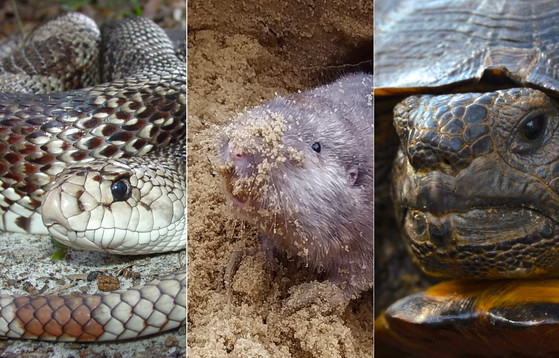 Digging it: pine snakes, pocket gophers and gopher tortoises (Dirk J. Stevenson, J.T. Pynne, Mark Krist)
By ETHAN HATCHETT
Animals are crafty. They have evolved complex survival strategies to meet the demands of their habitat. Through this change, many have become excellent architects.
Like their human counterparts, animal architects create structures and devices in many ways, excavating tunnel systems, collecting discarded items to cobble into homes, producing building supplies from their bodies and even using tools.
Join us for a four-part look at these native creatures and their fascinating adaptations. First up are excavators, from spade-nosed pine snakes to tunnel-happy “sandy mounders” and Georgia's hard-shelled king of earth movers.
Read Wild Architects: Part 1.
WILDLIFE PLAN PRIORITIES
It’s not inconsequential that these three are also listed as priority species in Georgia’s State Wildlife Action Plan. The plan is a statewide strategy to conserve native wildlife and the natural habitats they need before these animals, plants and places become rarer and more costly to conserve or restore.
Ethan Hatchett is a communications assistant in DNR’s Wildlife Conservation Section.
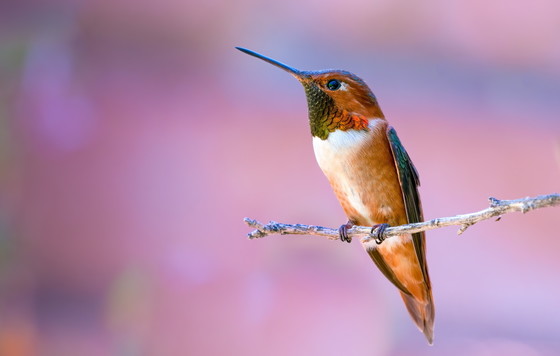 Keep an eye out for rufous hummingbirds.
By TERRY W. JOHNSON
One of the most fascinating things about birds is that, since they have wings, they can show up when and where they are least expected.
Case in point: the rufous hummingbird.
Rufous hummers are the most common hummingbird seen in Georgia during winter. However, often the first of these fall migrants reach the state in midsummer.
We don’t have any idea how often this happens, but I suspect it’s more frequent than we realize. Here’s why, plus tips for spotting these rare summer hummers. …
Terry W. Johnson is a retired DNR program manager and executive director of TERN, friends group of the agency's Wildlife Conservation Section. Check out past columns, his Backyard Wildlife Connection blog and his book “A Journey of Discovery: Monroe County Outdoors.” Permission is required to reprint a column.
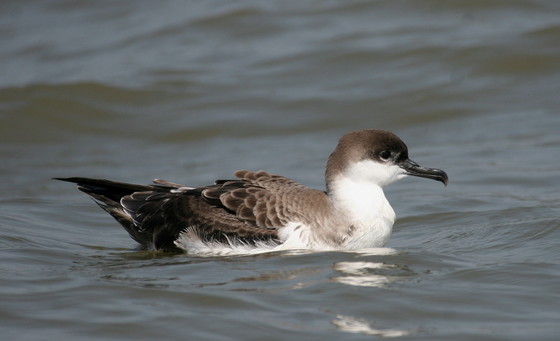 Great shearwater (Tim Keyes/DNR)
Dead great shearwaters found along the coast of Georgia and other Eastern Seaboard states point to one of the occasional die-offs that haunts these seabirds, a species that is otherwise rarely seen here. DNR wildlife biologist Tim Keyes said the problem is usually reduced forage resources in the south Atlantic Ocean, coupled with strong easterly winds in the north Atlantic that push dead or weakened shearwaters into shore. Although common, the pelagic birds seldom visit land except to nest – on islands in the south Atlantic – and sometimes during storms.
The record is within reach: As of Tuesday, loggerhead sea turtles had topped 3,700 nests on Georgia beaches this year. That edges the state's main marine turtle closer to the modern-day mark of 3,950 nests in 2019, even as nesting winds down and hatching ramps up (more than 9,000 loggerhead hatchlings and counting).
 Maureen, photographed earlier this century, did double-nesting duty this year. (Mark Dodd/DNR)
Maureen deserves part of the credit. One of 12 loggerheads first tracked in 2005 by DNR and UGA, the big female officially dubbed CC000162 usually nests in consecutive years – always on Blackbeard Island’s south end – but after nesting in 2021 she returned twice this year to lay eggs. Genetic analysis of a single egg collected from each nest is used to monitor loggerheads, including Maureen.
How to respect sea turtles and their nests, from Florida FWC.
One-in-5 reptile species worldwide is threatened with extinction, according to a new study. One ray of hope, according to research leaders NatureServe, Conservation International and the International Union for Conservation of Nature, is that extensive habitat work targeting other animals is “more likely than expected to co-benefit many threatened reptiles.”
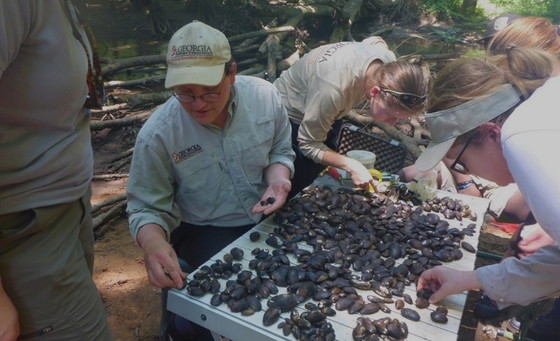 Checking mussel populations on the lower Flint and Chattahoochee (DNR)
More than 2,000 mussels representing nine species – three federally listed – were recently measured, tagged, checked for reproductive status and returned to the lower Flint and Chattahoochee rivers. The long-term monitoring by DNR, U.S. Fish and Wildlife Service, and the state Transportation Department is tracking aspects such as survival, reproduction and mussel responses to droughts and floods.
Too few butterflies were seen during some counts in the state last month. Atlanta Journal-Constitution columnist Charles Seabrook cited annual counts led by DNR’s Phil Delestrez and retired program manager Terry W. Johnson that mirrored the dismal results reported last year.
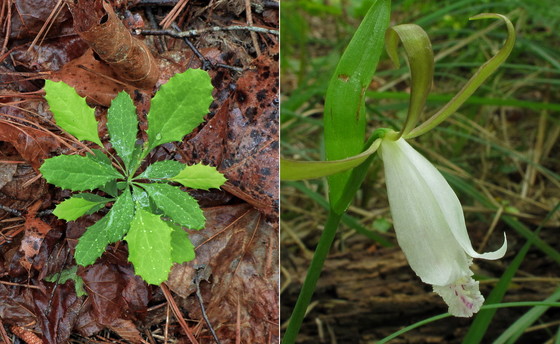 American barberry, left, and spreading pogonia (Alan Cressler)
Quick hits:
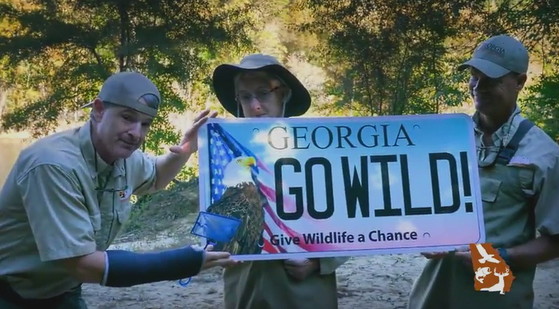 From 2017, vintage screenshot of Brett Albanese's tag rap ... just before the dipnet drop
Names in the news: Nineteen-year DNR veteran Dr. Brett Albanese has been named an assistant chief in the agency’s Wildlife Conservation Section. While continuing to help guide the Freshwater Biodiversity Program he previously managed, Albanese will coordinate the revision of Georgia’s State Wildlife Action Plan and work with legislation, policy and regulation changes. (Here’s hoping he also continues his conservation rap hobby.) Among the 62 high-school students chosen for Georgia 4-H’s Ambassador Program are 11 that plan to become certified Project WILD educators and teach people about wildlife conservation. The teens and their home counties: Katy Stinson and Kiwi Waller (Barrow County); Grant Shuman (Bryan); Catherine Puchala (Bulloch); Emmaline Cunningham, Tony Gray (Burke); Presley Douglas (Candler); Landon Fay (Cherokee); Connor Watson (Oconee); Reese Davis (Pickens); and Addy Winchester (Pulaski). Virginia Harman, a Rome attorney and lifelong Georgia resident, is the new chair of the Georgia Conservancy’s Board of Trustees.
WHAT YOU MISSED ...
In the previous Georgia Wild:
- Saving a "lost" fish
- Benefits of black cherry
- Snot otter sightings wanted
"Brunswick dredging delayed over sea turtle concerns," Georgia Public Broadcasting
"Have you seen a snot otter?" AllonGeorgia
(+audio) "Court: Regulators haven’t done enough to protect right whales," Portland (Maine) Press Herald
"Whale entanglements drop but remain major threat, feds say," WCSH/WLBZ-TV/News Center Maine (chs. 6/2, Bangor/Portland, Maine). Related: (+video) "Rescuers free entangled humpback whale off Cape Cod," Boston Globe.
"Will adaptability save North Atlantic right whales?" Canadian Broadcasting Corp.
"Warnock, Ossoff co-sponsor bipartisan wildlife bill," The Albany Herald
"Monarch populations may be doing better than thought," Georgia Public Broadcasting
"Reproductive ecology of southern spotted turtle populations," The Orianne Society (study)
"Okefenokee Swamp Park seeks World Heritage status," Savannah Morning News
"Two pythons, clutch of eggs, hatchlings removed from Big Cypress Preserve," Positively Osceola (Kissimmee, Fla.)
"Fla. agency on invasive species: We’re going on the offensive," Florida Politics
"Savannah River Reservoirs seeing growth from water willow plantings," Georgia Outdoor News
 Wildlife caught on camera along Atlanta's BeltLine Arboretum (Trees Atlanta/Georgia Audubon)
(video) "BeltLine cameras capture dozens of animals," WABE-FM (90.1, Atlanta)
Sea turtle nest inventory uncovers live hatchlings on Blackbeard Island, DNR
"Great blue heron drops big fish for tiny nestling," Cornell Lab Bird Cams clip from Landings (Savannah) cameras -- which have started streaming two nearby heron nests, instead of the great horned owl/osprey nest they usually focus on
(video) "Bear lands belly flop at Katmai National Park," USA Today. Live feed.
(video) "Field research, arts come together in course using cameras to record campus wildlife," Princeton University
CREDIT
Masthead: bald eagles on the nest (Curtis Compton/Atlanta Journal-Constitution)
Top
|